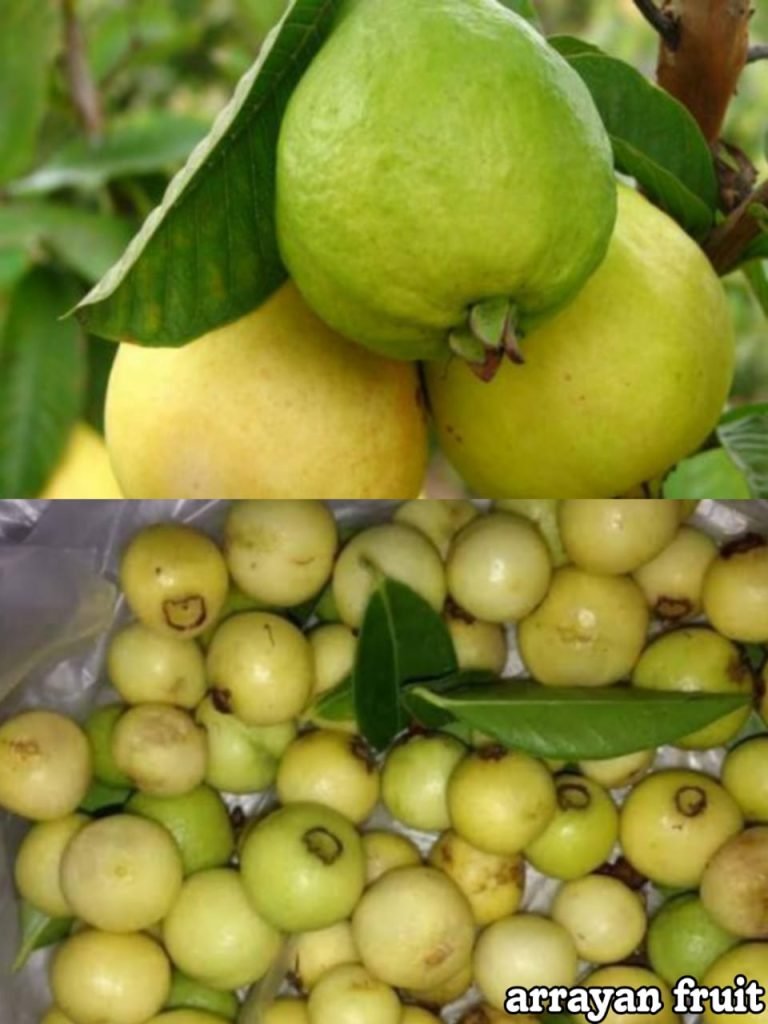Table of Contents
Introduction
The arrayan fruit is small and red. It grows on the arrayan tree. People refer to it as Chilean guava or ugni fruit. The fruit is present in South America, North America, and Asia. The fruit has a sweet and tart flavor. Its texture is like a grape. The array of fruit boasts a fascinating history that can trace back to the pre-Columbian era. The Mapuche, an indigenous people in southern Chile and Argentina, utilized the fruit in their traditional cuisine and medicine. It treated sore throat and stomach issues. Spanish explorers brought it to Europe in the 16th century. Europeans liked it, and it became famous among nobles and royals. Europeans began to cultivate it. Today, it’s a popular fruit worldwide. Historical records suggest that Queen Victoria of England had a particular fondness for the arrayan fruit.

Nutritional Benefits of Arrayan Fruit
The arrayan fruit is not just a flavorful fruit but also offers a wide range of health benefits. Some of the nutritional advantages of arrayan fruit include:
Abundance of Antioxidants
The high levels of antioxidants in arrayan fruit are one of its most notable health benefits. Antioxidants defend cells from free radicals. Free radicals contribute to chronic diseases like heart disease, cancer, and Alzheimer’s disease. Arrayan fruit has flavonoids, anthocyanins, and vitamin C, among other antioxidants. Research shows that arrayan fruit has more antioxidants than blueberries and strawberries.
Rich in Vitamins and Minerals
In addition to its high antioxidant content, arrayan fruit is a good source of vitamins and minerals. Arrayan fruit has many nutrients. It has a lot of vitamin C. Vitamin C is essential for wound healing, immune function, and collagen. It is also an excellent source of potassium, a mineral that regulates blood pressure, muscle function, and fluid balance. The fruit has calcium. Calcium is essential for bone health and muscle function. It also has iron.
Low in Calories and Fat
Despite its many nutritional benefits, arrayan fruit is low in calories and fat. One cup of sliced arrayan fruit contains only about 50 calories and less than one gram of fat. Arrayan fruit is a fantastic option for those mindful of their caloric intake or striving to lose weight. The fruit is not only low in calories and fat, but it is also an excellent source of fiber. It is vital for maintaining digestive health and inducing feelings of fullness, thereby promoting weight loss.
Read more: Fruit Baskets – The Assorted Healthy Gifting Option
How to Incorporate Arrayan Fruit into Your Diet?
If you’re looking to incorporate arrayan fruit into your diet, there are many delicious and creative ways. Here are a few ideas:
Eat it fresh: The most straightforward way to enjoy arrayan fruit is to eat it fresh as a snack or as a fruit salad.
Make jam or jelly: In South American cuisine, Arrayan fruit is used to make jam or jelly. It enjoyes on toast, crackers, or as a condiment for meats.
Add it to smoothies: Arrayan fruit adds to smoothies to give them a sweet and tart flavor.
Bake with it: Arrayan fruit can be used in baked goods, such as muffins, cakes, and pies.
Culinary Uses of Arrayan Fruit
The arrayan fruit boasts a distinctive taste and texture, so it is a sought-after ingredient in Latin American cuisine. Here are some of the culinary uses of arrayan fruit:
Traditional Uses in Latin American Cuisine
Latin American cuisine has utilized arrayan fruit for centuries. It is a critical ingredient in many traditional dishes, including desserts, jams, and sauces. Chileans make a traditional liqueur called “arrayan con agua ardiente” by steeping arrayan fruit in a mixture of aguardiente (a strong alcoholic beverage) and sugar. Colombians use arrayan fruit to make a sweet, caramel-like sauce called “aromáticas de arrayán” by boiling arrayan fruit with sugar and cinnamon.
Arrayan Fruit in Modern Cuisine
In recent years, arrayan fruit has become popular in modern cuisine. Chefs worldwide have discovered the unique flavor and texture of arrayan fruit and have found creative ways to use it in their dishes. Arrayan fruit, with its sweet and tangy flavor, adds a versatile touch to various culinary creations. From sweet treats like ice cream and cheesecake to savory dishes like salads and grilled meats, this fruit’s unique taste and texture make it a standout ingredient.
Arrayan Fruit in Beverages
Arrayan fruit is also a popular ingredient in beverages—arrayan fruit flavors cocktails, juices, and smoothies, besides the traditional arrayan liqueur. In Chile, people make a popular beverage called “mote con huesillo” using arrayan fruit. They soak dried peaches in sugar water and add cooked wheat and arrayan fruit. In Colombia, people make refreshing juice using arrayan fruit. They blend the fruit with water and sugar to create a sweet and tangy beverage.
Growing and Harvesting Arrayan Fruit
Arrayan fruit is a small, red fruit that grows on the arrayan tree, which is native to the Andean region of South America. Here is a closer look at growing and harvesting arrayan fruit:
The Arrayan Tree and Its Habitat
The arrayan tree is a remarkable evergreen that grows leisurely, reaching heights up to 15 meters, with its smooth, reddish-brown bark and delicate, white blossoms that bloom in the spring. The arrayan tree prefers moist, well-drained soil and grows best in relaxed, humid environments. It is commonly found in the high-altitude forests of the Andes Mountains, where it thrives in the cool, misty climate.
Sustainable Farming Practices
There has been a growing interest in sustainable farming practices for arrayan fruit in recent years. Sustainable farming practices focus on protecting the environment, promoting biodiversity, and ensuring the soil’s long-term health. One example of sustainable farming practices for arrayan fruit is using organic fertilizers and pest control methods. Organic fertilizers promote healthy soil and plant growth using natural materials such as compost and manure. Organic pest control methods, such as the use of beneficial insects and natural repellents, help to control pests without the use of harmful chemicals.
Challenges in Growing and Harvesting
Despite its popularity, growing and harvesting arrayan fruit can be challenging. One of the biggest challenges is the tree’s slow growth rate. It can take several years for an arrayan tree to produce fruit, which makes it difficult for farmers to establish a profitable crop. Another challenge is the delicate nature of the fruit. During harvest, arrayan fruit can easily get bruised and damaged, resulting in a lower yield and lower quality fruit. Additionally, the arrayan tree is susceptible to a variety of pests and diseases, which can impact its health and productivity of the tree.
Arrayan Fruit Around the World
People around the world enjoy arrayan fruit for their versatility. Let’s take a closer look at how the fruit is used in different parts of the world:
Arrayan Fruit in Latin America
Arrayan fruit is native to the Andean region of South America and has been an essential part of Latin American cuisine for centuries. Chileans make murtado liqueur from arrayan fruit. Peruvians make jam from it. Argentinians use it for arrope de arrayán, a sweet dessert. Arrayan fruit is also used in Latin American traditional medicine. It’s been used to treat digestive and respiratory problems. It has anti-inflammatory and antioxidant properties. It’s been used for mild to severe illnesses.
Arrayan Fruit in North America
Arrayan fruit isn’t as known in North America as in Latin America. However, some people in the United States and Canada enjoy it. People in the Pacific Northwest sometimes use arrayan fruit in their cuisine, even though it is primarily from Latin America. Additionally, some parts of the country grow the tree as ornamental plants. It’s beautiful and adds to any landscape.
Arrayan Fruit in Asia
Asia doesn’t often grow or use arrayan fruit, but it’s gaining popularity in some places. Japanese make mirto liqueur with arrayan fruit, similar to Chile’s murtado. Arrayan fruit is used in some traditional Asian medicines. It has anti-inflammatory and antimicrobial properties. It’s used for various health concerns, from digestive issues to skin conditions. It has a rich history as a natural remedy.
Conclusion
In conclusion, arrayan fruit is a remarkable superfood that offers a range of nutritional and health benefits. It is high in antioxidants, vitamins, and minerals and low in calories and fat, making it a perfect addition to a healthy diet. Moreover, its versatile culinary uses in traditional and modern cuisine make it a valuable ingredient for food and beverage enthusiasts worldwide. Arrayan fruit is expected to gain more popularity due to its vast potential in global cuisine. With its unique and exotic flavor, the fruit can add an exciting twist to any dish or beverage, creating a new market for fruit farmers. The growing interest in organic and natural foods also supports the potential for the arrayan fruit to become a more popular ingredient in various cuisines worldwide.
Apart from that, if you want to know about Exploring Gongoli Health Benefits: From Headaches to Anemia, then please visit our Health category.
FAQs
Arrayan fruit is a small, reddish-purple fruit that grows on the arrayan tree, native to the forests of South America.
Arrayan fruit is rich in antioxidants, vitamins, and minerals and low in calories and fat, making it a great addition to a healthy diet.
In Latin America, people often use arrayan fruit for jams, jellies, and pastries. It’s also eaten fresh as a snack.
Yes, arrayan fruit has gained popularity in modern cuisine and can be used in various sweet and savory dishes and beverages.
Arrayan fruit grows in other parts of the world, including North America and Asia, but growers may not make it as widely available as other fruits.
Arrayan fruit grows on the arrayan tree. The tree requires a specific habitat and sustainable farming practices to thrive. Farmers harvest the fruit by hand and handle it carefully to avoid bruising.
Arrayan fruit has the potential to become a more widely used ingredient in global cuisine, given its unique flavor and nutritional benefits.
We can support sustainable farming of arrayan fruit by promoting fair trade practices, supporting organic and natural farming methods, and conserving the natural habitats and ecosystems where the arrayan tree grows.


























